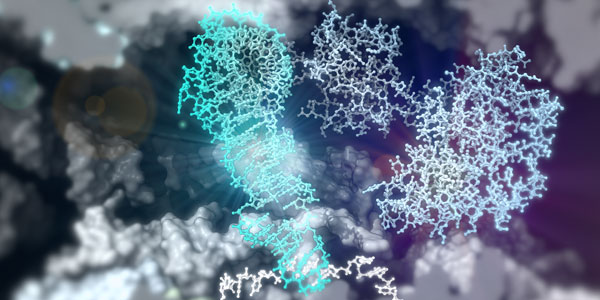York research delivers new understanding of cells’ survival ability
The Cryo-EM facility and Viking cluster in York have played a major role in increasing understanding of bacterial cells’ ability to survive when threatened; understanding which could lead to more effective medicines in the future.

Dr Chris Hill (York Structural Biology Laboratory, York Biomedical Research Institute, Department of Biology) is a senior author on “A new family of bacterial ribosome hibernation factors” - published in the prestigious Nature.com - which is the result of a collaborative study between the Universities of York, Texas and Newcastle.
Chris explains the essence of the group's findings: “In the inner workings of a cell, it's known that ribosomes carry out the vital function of creating proteins to allow the cell to move or grow or communicate,” he says.
“But ribosomes are fragile and so the cell wants to protect them as much as possible - If ribosomes can’t create protein for a long time, the cell will die.”
Cells can be threatened by a vast number of factors - medication, excessive heat, cold, hydration or dehydration can all “stress” bacterial cells, and Chris says that one way cells have developed to protect their ribosomes from these stresses is to use Hibernation Factor Proteins, which bind to ribosomes and protect them.
And his collaborative research has discovered an entirely new group of these factors in 20 per cent of all known bacteria. The protein - called Balon - can enable the ribosomes to pause their activity, crucially part way through a protein-manufacturing cycle, to protect the cell. The team used cryogenic electron microscopy (cryo-EM) to take a series of “snapshots”, revealing the atomic details of exactly how Balon fits into ribosomes from several species of bacteria (pictured).
“It’s long been known that different bacteria grow and divide at very different rates,” says Chris. “But it turns out they also make proteins at different rates too. For example, an E.coli ribosome can make a protein in just 20 seconds, whereas it’ll take a M.tuberculosis (TB) ribosome a full 20 minutes. And it’s a fact that the faster-growing bacteria have been historically easier to study, and this bias has affected our understanding and assumptions.”
He says the hitherto-unknown ability for a cell to pause its ribosomes in this way is particularly helpful for the slower-functioning bacteria, such as TB.
He said: “Before this study, scientists had thought that ribosomes could only hibernate if they had completely finished making a protein. In the case of slower-functioning bateria like TB, if a ribosome is halfway through a twenty-minute cycle and the cell becomes threatened, this would be an unacceptable delay.
“One of our main findings is that this new hibernation factor, Balon, can be loaded into ribosomes while they are still making their proteins, meaning they can quickly pause protein manufacture if need be; a very useful survival technique.”
Chris says having this new knowledge about how harmful bacteria survive, could be vital in the fight against them.
He says: “Any improved understanding of how bacteria make proteins is going to be helpful.
“A ribosome is one of the most essential pieces of machinery in a cell - if a cell can’t synthesise protein, it dies. So this greater understanding of bacterial protein synthesis will enable us to better understand disease-causing bacteria and could highlight potential new avenues for therapeutic intervention.”
Notes to editors:
This study was carried out in collaboration with the research groups of:
- Dr Sergey Melnikov at the Biosciences Institute, Newcastle University, Newcastle upon Tyne, UK
(sergey.melnikov@newcastle.ac.uk) - Dr Matthieu Gagnon at University of Texas Medical Branch, Galveston, TX, USA
(magagnon@utmb.edu)